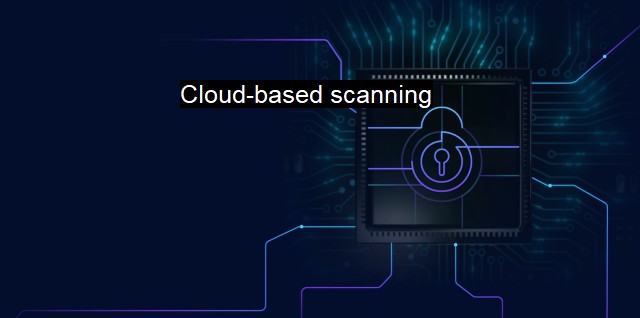What is Cloud-based scanning?
Unleashing the Power of Cloud-Based Scanning: Strengthening Cybersecurity Framework for Businesses of All Sizes
Cloud-based scanning, a modern solution in the cyber security landscape, refers to the technique of using internet-based resources to identify potential security threats, infections, and vulnerabilities in digital systems. Often implemented as part of an antivirus and cybersecurity strategy, this approach is designed to provide a higher scale of security coverage by leveraging the power of the cloud technology.Cybersecurity remains a critical concern for all technological environments as hacking threats, viruses, and malware evolve in complexity and method over time. The traditional on-premise antivirus framework which relies solely on local server resources to detect and eliminate cyber threats is growing inefficient against the advancement of tech threats. This is where cloud-based scanning comes into the picture.
A cloud-based scanning tool is an antivirus program operating over the internet and is hosted in the cloud as opposed to being installed and running on a local server or system. It's a software-as-a-service (SaaS) mode of distribution where the antivirus software can scan and fix potential issues across multiple devices connected to the cloud. The clients rely on the service provider's infrastructure for threat detection and resolution mechanisms which, in return, lessens the hardware tension on user's machines.
One of the primary tenets of cloud-based scanning is the concept of real-time threat detection. The power of high-speed data processing enabled by the cloud allows for continuous scanning and instant threat recognition, without placing significant demands on the user's hardware resources. Because these tools are hosted online, they always have up-to-the-minute threat definitions, providing real-time, proactive protection against the most recent security threats.
Scalability is another advantage that easily sets cloud-based scanning ahead of traditional antivirus software. Since the system is based in the cloud, it can conveniently expand the spectrum of its services by the cloud's stretching abilities, not restricted by the local computer power. So said, numerous systems can be efficiently serviced and protected without the need to upgrade individual hardware setups.
The decentralization of threat analysis and processing in cloud-based scanning ensures data protection even if the user's system crashes. All threats detected are analyzed in the cloud, creating a wall of defense between the threat and the user's capabilities. If potentially malicious software slips onto a device, the local copy of the antivirus can communicate with the expansive databases in the cloud to identify, isolate, and nullify the threat effectively.
Cloud-based scanning also promotes quick disaster recovery if an attack successfully brings down devices or networks. The cloud system has the capability to store and manage data in an off-site safe location. And since each byte of data is scanned and replicated in real-time in the cloud, recovery in the aftermath of a cyber attack is comparatively faster.
While cloud-based scanning provides many perks, it also has some drawbacks to take into account, such as dependency on a stable internet connection. As with all internet-based services, cloud-based antivirus programs can only function well if there is a reliable web connection.
Issues of privacy protection and data leakages sometimes pose concerns. Even though robust encryption techniques are in use, cybersecurity practitioners are persistently working to reinforce the safety and confidentiality of data with advanced tools and practices.
Despite these challenges, cloud-based scanning continues to offer an efficient shield of cybersecurity in an era driven exponentially on digital data. By blending into the strengths of cloud technology, it promises more effective, real-time, and scalable solutions apart from fostering disaster resilience for digital systems.

Cloud-based scanning FAQs
What is cloud-based scanning?
Cloud-based scanning is a cybersecurity process that involves using cloud computing resources to analyze and detect potential security risks and vulnerabilities in an organization's systems. It is implemented by deploying antivirus software that can scan and detect malicious files and behaviors in real-time from a remote server located in the cloud.How does cloud-based scanning work?
Cloud-based scanning works by installing antivirus software on devices within an organization that scans for potential security threats. The antivirus software sends data to a remote server located in the cloud, which analyses the data using machine learning algorithms that provide real-time protection against emerging security threats. The cloud server then communicates the results of the analysis back to the devices, allowing for immediate actions to be taken to mitigate any threats.What are the benefits of cloud-based scanning?
Cloud-based scanning provides several benefits to organizations, including the ability to detect and respond to security threats in real-time, the ability to scale quickly and efficiently, and lower costs compared to traditional on-premise security solutions. Additionally, cloud-based scanning can help reduce the workload of internal IT teams by offloading security management to a remote team of experts.Is cloud-based scanning secure?
Yes, cloud-based scanning is secure. It utilizes encrypted channels and secure protocols to transmit data between the devices and the cloud server, ensuring that sensitive information is protected. Additionally, cloud-based scanning providers implement strict security measures such as access controls, intrusion detection and prevention, and vulnerability management to ensure the security of their services.| | A | | | B | | | C | | | D | | | E | | | F | | | G | | | H | | | I | | | J | | | K | | | L | | | M | |
| | N | | | O | | | P | | | Q | | | R | | | S | | | T | | | U | | | V | | | W | | | X | | | Y | | | Z | |
| | 1 | | | 2 | | | 3 | | | 4 | | | 7 | | | 8 | | |||||||